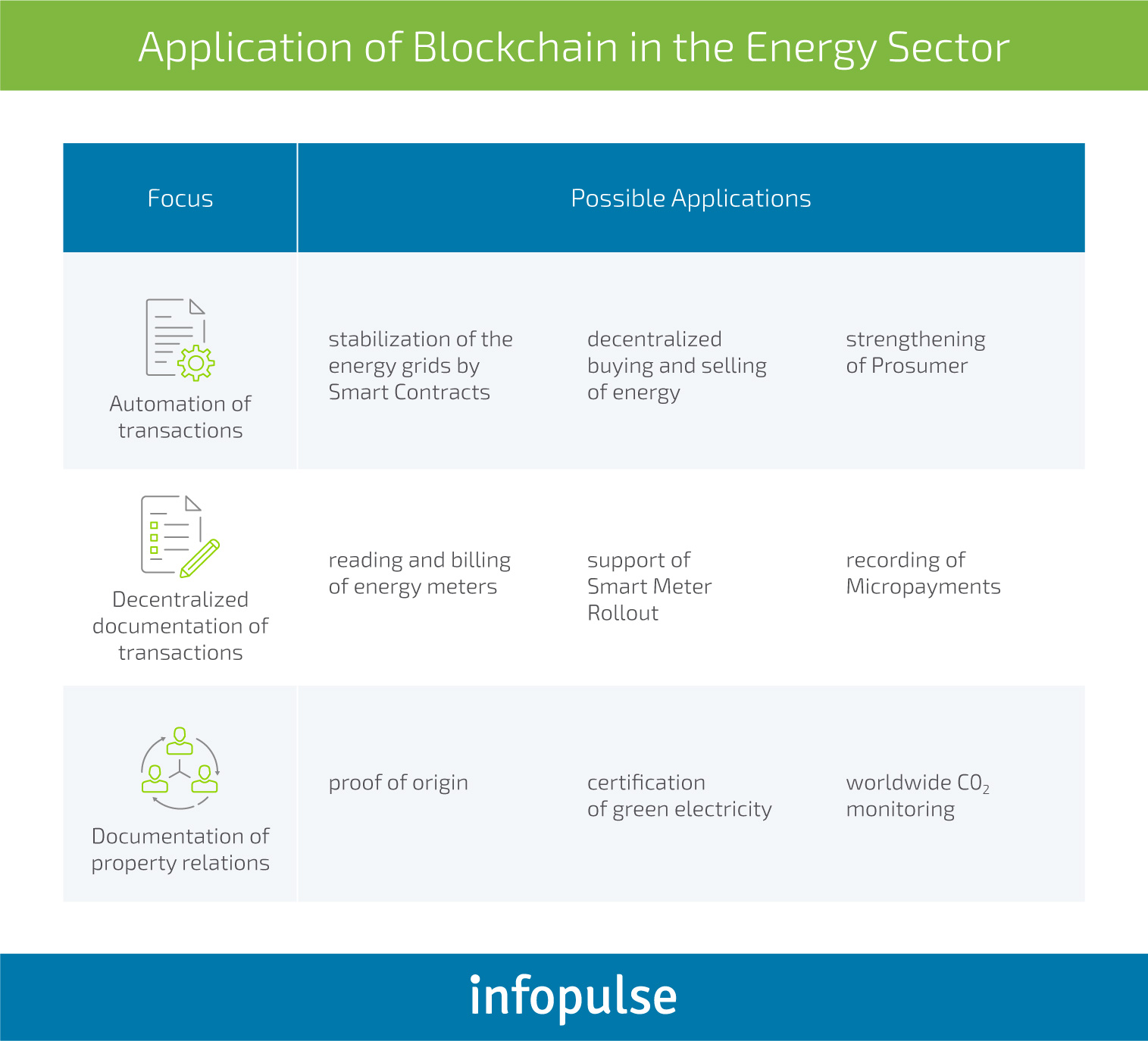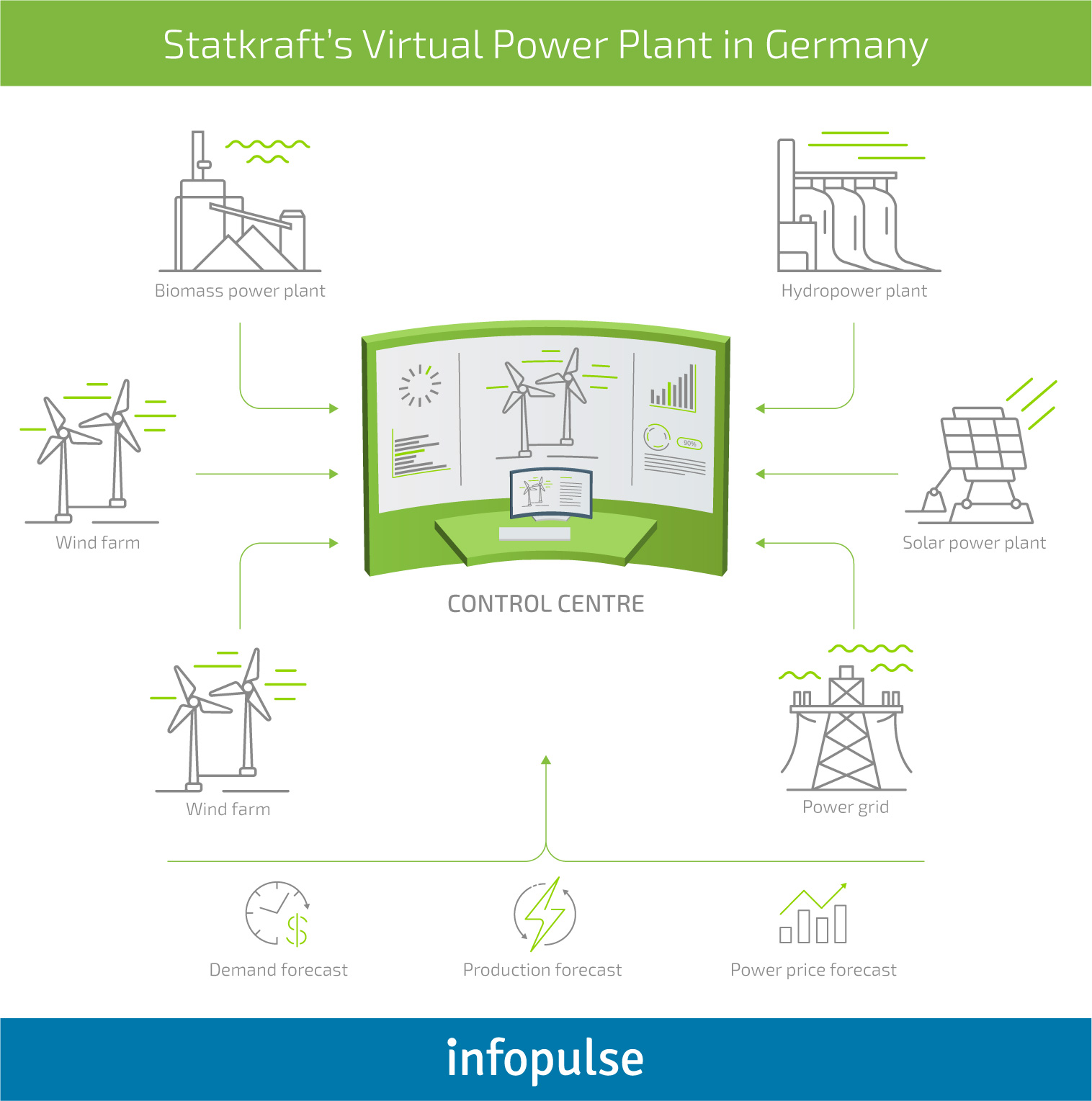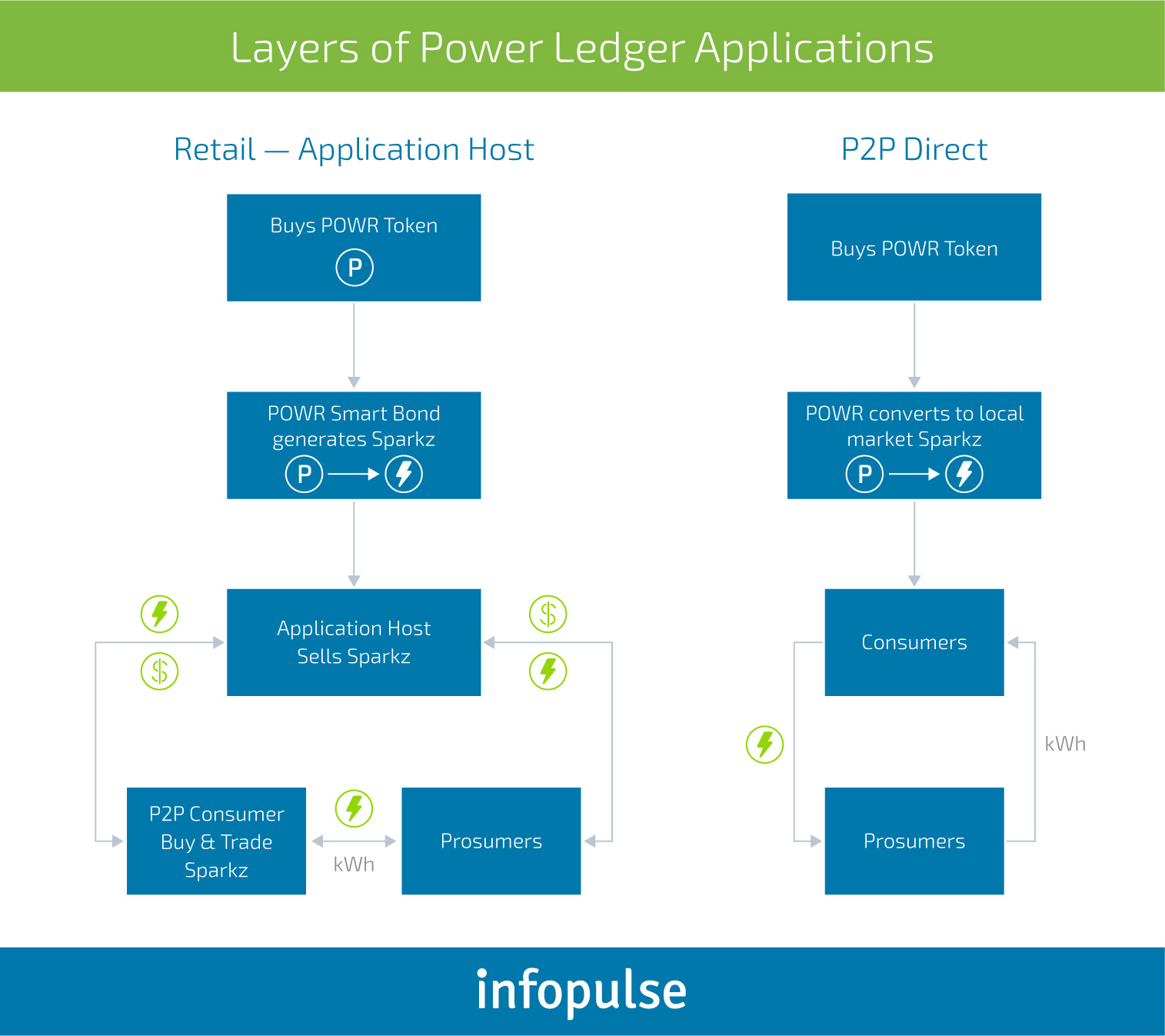Reshaping the Energy Industry with Blockchain
The population of urban areas is soaring, and the need for electricity is rising each year. Furthermore, these areas account to roughly 70% of global CO2 emissions, and so they need to be controlled to ward off extensive air pollution. The majority of governments create “sustainable city” initiatives to enhance the energy-efficiency with blockchain as the key platform.
Blockchain fuels that rapid progress within the energy market. It can bridge the supply/demand electricity gap, improve the microgrids technologies, and make an enormous contribution to energy storing, renewable energy, electric cars and more.
Pilot blockchain-based energy efficiency projects are becoming increasingly popular in different parts of the world. Recently, the Australian government has invested more than $6 million into a blockchain smart utility project that is aimed to advance the peer-to-peer energy exchange. Moreover, newly-developed startups are joining the energy domain. One of the most prominent – Grid+, which is an American startup that plans to launch a device that is designed to purchase and sell electricity via Ethereum.
Leveraging Blockchain into the Energy Industry
Peer-to-peer Trade via Smart Contracts
The most far-reaching application of blockchain in the energy sector is that application of smart contracts. This technology has the potential to alter the conventional energy supply models. Smart contracts automatically balance the supply & demand by including a series of set rules for the transactions. For example, if there’s an extra amount of energy, the surplus may be instantly sent into storage. In due course, if there’s insufficient output or the energy needs to be retextured to other sources, the excessive amount that was spared may be used.

However, today energy producers can mostly sell the energy back to the grid instead of trading it with another party. Energy exchange is restricted by the centralized regulations of the Distributed Energy Resources (DER). Blockchain-based technologies can make this system more flexible and contribute to the development of a customer-centric market. A recent Blockchain Program in Western Australia has created more trading opportunities and granted additional control of the electricity to the citizens. The program allows to buy, sell or exchange excessive energy with any resident linked to the Western Power network.
The European Union has recently issued a new policy entitled “The New Energy Market Design” that promotes the creation of small energy markets. The idea is to establish an ecosystem that combines blockchain, efficient metering systems, and advanced next-generation batteries that are capable to assemble energy locally. The included smart meters will transfer the data about the gathered energy to the distributed ledger which, in its case, will turn it into the form of an “energy coin”. These coins could later be sold or reacquired by the owners in case of need.
Data Storage and Energy Contract Management via Blockchain
Smart Contracts have the potential to promote and simplify the cooperation between energy suppliers and consumers. Today complex administrative routines are tiresome for the customer and quite costly for the supplier. For example, to change the provider the customer needs to close the remaining contract, spent a lot of time to create a new one, study the new terms& conditions etc. The usage of blockchain will optimize the sequence of operations and enable the client to finish the deal with the suppliers in a matter of a few clicks. Such method will pave the way into a more competitive energy retail market. A vivid example of such technology is a British startup “Electron” that is currently developing a blockchain platform that will allow switching power suppliers within one day. The startup developers have also teamed up with the Uk’s Data Communications Company to ensure a more effortless switch for new clients.
The transaction data will be safely stored on the blockchain platform, its audit will be simplified and the probability of cybercrimes will be utterly excluded. In prospect, implementing this technology can create an amplified and safe storage of all ownership records and any transactions related to them. Additionally, this blockchain database can be used to review and manage renewable power, as well as to control emission allowances.
Enhanced Performance of Virtual Power Plants
Virtual Power Plant (VPP) is a Cloud-based network of energy generating and storing units, which is designed to increase power generating and allow an open market energy trade.

Depending on the current demand and the market prices, VPP’s may remotely set the production and the spreading of energy, while simultaneously responding to any changes. Virtual Power Plants can optimize energy flow and improve the usage of electric energy through the entire network.
VPP can accumulate the available resources, like solar panels, microgrids, and energy storing installations, and match the resources with the demand levels. Such operations may be executed transparently via smart contracts. The entrepreneurs who participate in this scheme will receive rate cuts for decreasing their power consumption.
Automation of Billing for E-cars & Gadgets with Blockchain
While the adoption of E-cars keeps growing, there’s a striking shortage of public charging stations. The major reason behind this is that there’s no appropriate billing model for these stations. In this case, blockchain together with advanced paying methods may be very appropriate. Measures that include blockchain may mechanize the whole process. The driver’s car is charged automatically, and the billing is made by the system directly after the driver leaves the station. What’s more, in the future the bills may be brought together and included in the general monthly electricity bill of the driver.
The blockchain system may let the electric companies set different prices on the energy depending on their current resources and issue a more profitable bill for the user in comparison with charging the car overnight.
The concept of “Smart cities” has been making its headway for the past few years. Due to its development, the cities need to use a new system of storing, transmitting and processing data that operates in a multitude of IoT devices. Establishing blockchain is a perfect choice because this technology allows real-time, cost-efficient, and secure ways of facilitating data between the city’s devices, like smart streetlights.
Blockchain in the energy industry keeps developing, yet its success depends on many factors, like the technological advancement, governmental support and the establishment of an appropriate legal and administrative framework, as well as investment dynamics.
Success Stories of Blockchain in the Energy Industry
Power Ledger – A Peer-to-peer Energy Trading Network
In 2016 an Australian startup Power Ledger began the demonstration of their new decentralized energy focused project. The project provides the opportunity for the users to sell redundant solar energy to the neighbors. The pilot project continued for 8 weeks and tracked the real-time energy consumption in 20 households by using the installed meters. The project turned out to be a perfect tool for information-intensive applications that are used in peer-to-peer trade. Moreover, the network has a secure proof-of-stake mining, its energy efficient and eco-friendly. As the project specializes in global blockchain verification technology, it allows the power meters to communicate directly with the network thus removing different hardware related issues.

The project was launched in two Australian cities – Victoria and Perth, and currently, the owners plan to expand. This expansion will support the progressive model for consumer-generated and shared electricity. Australian weather is a great advantage because it has over 300 warm and shining days a year, and the implementation of this project may dramatically decrease the costs for using solar panels. What’s more, the project founders began cooperating with renewable energy developers from Thailand and North America to share the project’s benefits.
The profit of this technology is that it allows selling excessive energy for a lower promotional rate. Additionally, you can sell the energy back for a lower feed-in tariff (FIT) and then purchase it again at a higher rate from the grid. Because the Australian FIT is decreasing, startups like Power Ledger may have a positive impact on the energy industry, and alter the energy trade.
Similar blockchain models have the potential to modify the conventional methods of utility sharing and consumption. The peer-to-peer technology decreases the expanses for energy production and acquisition while providing a free energy trade for every user.
Challenges of Adopting Blockchain in the Energy Sector
The energy sector is heavily restrained with a wide range of regulations that vary from country to country, so the blockchain adoption in this branch could be quite time-consuming. To begin using blockchain the regulators will need to come to terms with aligned operational protocols, which is a very tiresome effort. The establishment of a decentralized electricity supply network may raise a series of critical issues in compliance, for example:
Who will be in charge of creating and issuing schedules and forecasts to the gearing system operators?
The daily forecasts for the entire market need to be created and submitted at least one day in advance. These forecasts are based on previous schedules that are done by a balancing team of managers. But due to the core principle of blockchain, which is decentralization, this means that all consumers simultaneously become energy managers as well. The issue is – how the relationships between the participants need to be settled to ensure timely submission of the schedules.
Which participant should be considered an electricity supplier?
Once again, due to the decentralization, any user may be an energy supplier. The issue is that due to regulatory terms, electricity suppliers are obliged to own a special license, the purchase of which is rather expensive. As a result, the overwhelming majority of users who usually participate in small operations wouldn’t want to buy the license.
Who is responsible for liabilities?
The decentralized approach raises an issue of obligations and responsibilities in terms of technical deficiencies, intentional item damaging and payment issues. Before adopting the blockchain system into the energy sector, different set of rules and regulations must be developed to ensure effective liability.
How long will it take to leverage blockchain into the energy sector?
The blockchain adoption process will most like be very time-consuming due to the fact that the majority of the citizens neglect innovations, and do not want to change their purchase and consumption routines. The solution to accelerate the adoption process is to develop specific types of consumer applications. The first being a solution that enables the users to make a wide range of transactions, like monitoring consumption, trading patterns, forecasting the supply & demand etc. The second being the development of automated solutions for users who are not willing to spend time on these actions.
Conclusion
Regardless of certain challenges that may arise during blockchain adoption, still this technology has the potential to seriously benefit the energy sector. Currently, progressive governments recognize the value of blockchain and begin to actively leverage it. As a result, transparency is improved, which is an advantage for supervisory bodies and regulators, and most importantly, it provides great convenience for the citizens.
Want to see how blockchain can benefit the energy industry? Contact us for a free consultation.



![CX with Virtual Assistants in Telecom [thumbnail]](/uploads/media/280x222-how-to-improve-cx-in-telecom-with-virtual-assistants.webp)
![Power Apps Licensing Guide [thumbnail]](/uploads/media/thumbnail-280x222-power-apps-licensing-guide.webp)
![Expanding NOC into Service Monitoring [thumbnail]](/uploads/media/280x222-best-practices-of-expanding-telecom-noc.webp)
![Cloud-Native for Banking [thumbnail]](/uploads/media/cloud-native-solutions-for-banking_280x222.webp)
![Generative AI and Power BI [thumbnail]](/uploads/media/thumbnail-280x222-generative-AI-and-Power-BI-a-powerful.webp)
![Data Governance in Healthcare [thumbnail]](/uploads/media/blog-post-data-governance-in-healthcare_280x222.webp)
![Super Apps Review [thumbnail]](/uploads/media/thumbnail-280x222-introducing-Super-App-a-Better-Approach-to-All-in-One-Experience.webp)
![SAP Service Insight [thumbnail]](/uploads/media/Service Insight-Infopulse-SAP-Vendor-280x222.webp)
